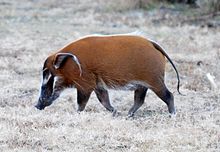Brush ear pig
| Brush ear pig | ||||||||||||
|---|---|---|---|---|---|---|---|---|---|---|---|---|

Brush ear pig in the Hagenbeck zoo |
||||||||||||
| Systematics | ||||||||||||
|
||||||||||||
| Scientific name | ||||||||||||
| Potamochoerus porcus | ||||||||||||
| ( Linnaeus , 1758) |

The brush ear pig or river pig ( Potamochoerus porcus ) is a species of mammal from the family of real pigs (Suidae).
features

Brush-eared pigs are among the most strikingly colored pigs. The basic color of their fur is reddish-brown, a white eel line extends along the back . The face is colored black with white circles under the eyes and a white trunk. The long whiskers and the eponymous black or white tufts on the leaf-shaped ears are characteristic. Both sexes have tusks. These elongated canines grow from the upper and lower jaw and grind against each other. The males also have wart-like protrusions on the nasal bone below the eyes.
The body is round, the legs are short and strong and the tail is relatively long, except for the tassel, hairless. These animals reach a head trunk length of 100 to 150 centimeters, a shoulder height of 55 to 80 centimeters and a weight of 45 to 120 kilograms.
distribution and habitat
Brush ear pigs live in western and central Africa, their range extends from Senegal to the Democratic Republic of the Congo . They are not fussy about their habitat and can be found in forests as well as in savannas and swamps. However, they avoid overly dry areas.
Way of life
These pigs are nocturnal, during the day they retreat to self-dug hollows in deep vegetation. They live in family groups of 2 to 15 animals, often accompanied by a boar. They are territorial and mark their territories with glandular secretions or by scratching tree trunks with their tusks. The mane and tassels can be set up to make the animal appear taller.
When threatened, they can run quickly and swim well. Sometimes they defend themselves against their predators (mostly cats or hyenas ) by attacking them.
food
Brush-eared pigs are omnivores that eat roots, tubers and fruits, but also insects, small vertebrates and carrion.
Reproduction
After a gestation period of around 120 to 130 days, the female gives birth to one to six (on average four) young. The newborns wear light-colored strips of fur, they flee the nest and can follow the mother shortly after birth. The males and females in a group take care of the offspring, which are weaned after two to four months and become sexually mature at two to three years of age.
Brush ear pigs and people
After the natural enemies of the brush ear pigs such as leopards were decimated by humans, some of them have spread considerably. In some places they are viewed as a plague, as they can invade plantations and devastate them. Overall, the species is widespread and is not an endangered species.
Systematics
The brush-eared pig and the bush pig were previously considered to be a common species. Today they are listed as separate species, also due to the differences in appearance (bush pigs are less colorful) and the separate distribution area (bush pigs live in eastern and southern Africa). Together they form the genus of the bush pigs ( Potamochoerus ).
literature
- David M. Leslie Jr., Brent A. Huffman: Potamochoerus porcus (Artiodactyla: Suidae). Mammalian Species Volume 47 (919), 2015; Pp. 15-31. doi: 10.1093 / mspecies / sev002
- Ronald M. Nowak: Walker's Mammals of the World . Johns Hopkins University Press, Baltimore 1999. ISBN 0-8018-5789-9
Web links
- Brush ear pig on Ultimate Ungulate (English), with more photos and distribution map
- Potamochoerus porcus in the endangered Red List species the IUCN 2006. Posted by: Pigs & peccaries Specialist Group, 1996. Retrieved on 12 May, 2006.


